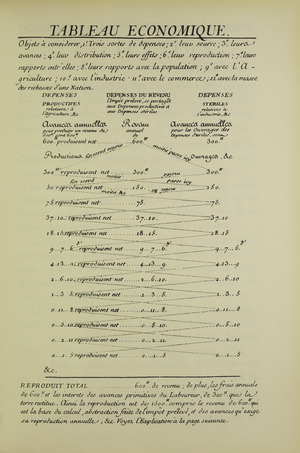François Quesnay facts for kids
Quick facts for kids
François Quesnay
|
|
|---|---|
 |
|
| Born | 4 June 1694 Méré near Versailles
|
| Died | 16 December 1774 (aged 80) |
| Era | Age of Enlightenment |
| Region | Western philosophy
|
| School | Physiocrats |
|
Main interests
|
Political economy, sinology |
|
Notable ideas
|
Laissez-faire |
François Quesnay (born June 4, 1694 – died December 16, 1774) was an important French thinker. He was both an economist and a physician. He belonged to a group of thinkers called the Physiocrats.
Quesnay is famous for his book, the "Tableau économique" (Economic Table), published in 1758. This book was one of the first to try and explain how an economy works in a detailed, analytical way. It helped create many ideas in modern economics. He also wrote about Chinese politics and society in his book Le Despotisme de la Chine in 1767.
Contents
Life of François Quesnay
Quesnay was born in Méré, a small town near Versailles, France. His father was a lawyer and owned some land. At 16, Quesnay began training to be a surgeon. He moved to Paris to study medicine and surgery.
Becoming a Royal Physician
After becoming a master surgeon, he started his own practice. In 1737, he became a permanent secretary of a surgery academy. He also became a surgeon to King Louis XV. By 1744, he earned his medical degree. He then became the king's personal physician and moved into the grand Palace of Versailles.
King Louis XV thought highly of Quesnay. He even called him "his thinker." When the king made him a nobleman, he gave him a special symbol: three pansy flowers. The word "pansy" comes from the French word pensée, which means "thought." His motto was Propter cogitationem mentis, meaning "for the thought of the mind."
Starting the Physiocrats
While at Versailles, Quesnay focused on studying economics. Around 1750, he met Jacques Claude Marie Vincent de Gournay. Gournay was also very interested in economic ideas. Together, they formed a group of thinkers called the Économistes, later known as the Physiocrats.
Many smart people joined their group. Some famous members included Victor de Riqueti, marquis de Mirabeau and Pierre Samuel du Pont de Nemours. Even Adam Smith, a famous Scottish economist, met Quesnay and his followers when he visited Paris. Smith later praised their ideas in his own important book, Wealth of Nations.
Quesnay married Marianne Woodsen in 1718. They had a son and a daughter. He passed away on December 16, 1774. He lived long enough to see his student, Anne Robert Jacques Turgot, Baron de Laune, become France's finance minister.
Quesnay's Economic Ideas
Quesnay's most famous work is the Tableau économique (Economic Table), published in 1758. This book was a groundbreaking attempt to show how an economy works. It was one of the first times someone tried to describe economic processes in a scientific way.
Understanding the Economic Table
The Tableau économique used special diagrams and formulas. It showed how wealth, mainly from farming, moved between different groups of people in a country. Quesnay believed that agriculture was the only true source of wealth.
He divided society into three main classes:
- Proprietary class: These were the landowners.
- Productive class: These were the farmers and agricultural workers.
- Sterile class: This group included manufacturers and merchants. Quesnay thought they didn't create new wealth, but only changed existing wealth.
Quesnay believed that if the economy was completely free, wealth would flow in a natural way. He also showed what happens when governments try to control or regulate the economy too much. He argued that such controls could harm the whole society.
Views on Taxation
Quesnay had strong opinions about taxes. He believed that taxes on farmers (the productive class) were harmful. He thought these taxes would make farmers less likely to produce food, which would hurt the whole country.
Instead, Quesnay argued that landowners (the proprietary class) should pay most of the taxes. He felt that taxing landowners would not stop production. He also opposed indirect taxes, which are taxes added to goods and services. He thought these taxes unfairly burdened ordinary people. He wanted more direct taxes on landowners to help the country's finances and boost agriculture.
Quesnay and China
Quesnay was also very interested in Chinese politics and society. His 1767 book, Le Despotisme de la Chine, described his ideas about the Chinese imperial system.
He admired how China gave political power to scholars based on their skills, rather than just their family name. He also believed that agriculture was extremely important for a nation's well-being, a view he saw reflected in China.
Because he admired Confucianism, a Chinese philosophy, Quesnay's followers sometimes called him the "Confucius of Europe." His love for Chinese culture even led him to suggest that King Louis XV's son should perform a special "plowing of sacred land" ceremony, just like the Chinese emperor did. This would show the strong connection between the government and farming.
See also
 In Spanish: François Quesnay para niños
In Spanish: François Quesnay para niños
- Contributions to liberal theory
- History of economic thought
- Liberalism
- Ronald L. Meek
- Circular flow of income



